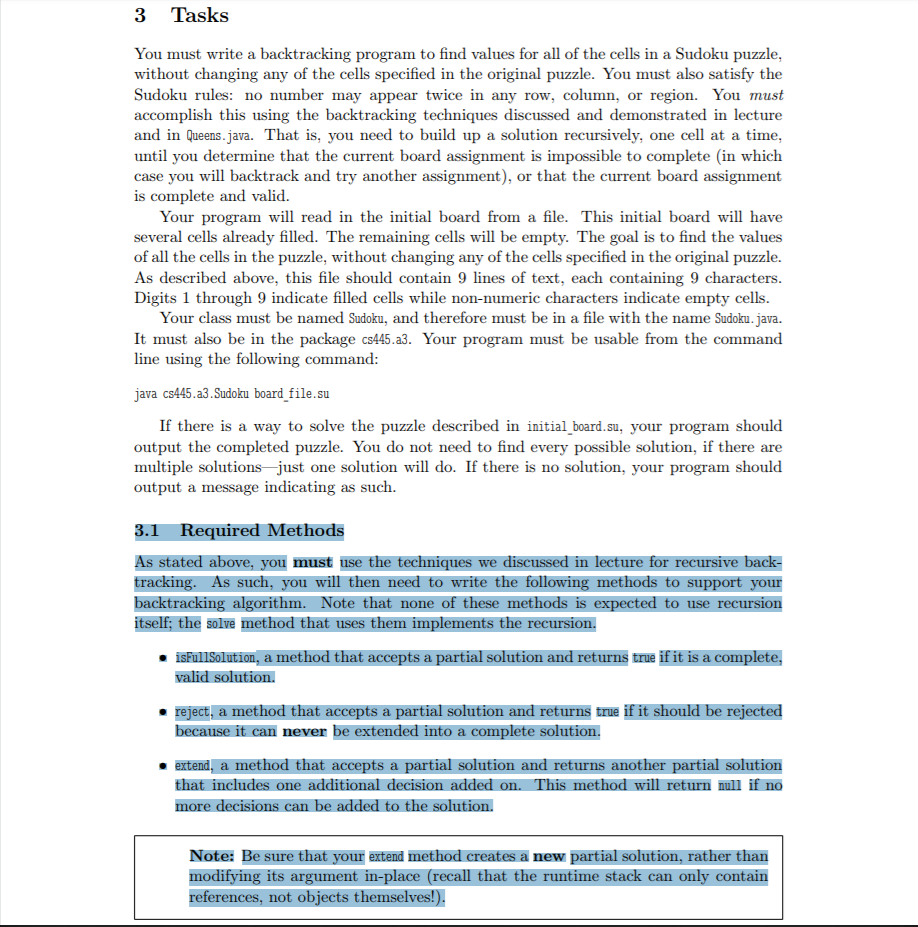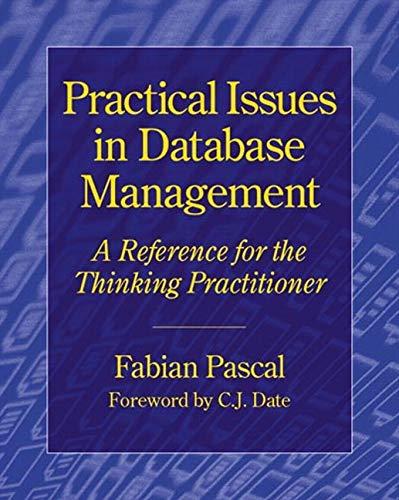Answered step by step
Verified Expert Solution
Question
1 Approved Answer
import java.util.Arrays; public class Queens { /** * Checks if a partial solution is a complete solution. * @param partial The partial solution * @return

import java.util.Arrays; public class Queens { /** * Checks if a partial solution is a complete solution. * @param partial The partial solution * @return true if the partial solution is complete, false otherwise. */ public static boolean isFullSolution(int[] partial) { // Check that all queens were placed for (int i = 7; i >= 0; i--) { if (partial[i] == 0) { return false; } } // Since we checked that the solution is complete, and since isFullSolution is called after // reject, it must also be valid return true; } /** * Checks if a partial solution should be rejected because it can never be extended to a * complete solution. * @param partial The partial solution * @return true if the partial solution should be rejected, false otherwise. */ public static boolean reject(int[] partial) { // Check every pair of queens to see if they are in conflict for (int i = 0; i for (int j = 0; j if (partial[i] == 0 || partial[j] == 0) { // One of these queens is not placed, so they cannot be in conflict } else if (i != j && partial[i] == partial[j]) { // These queens are in the same row return true; } else if (partial[j] - partial[i] == j - i) { // These queens are in the same positive diagonal return true; } else if (partial[j] - partial[i] == i - j) { // These queens are in the same negative diagonal return true; } } } // No pair of queens was in conflict, so we should not reject return false; } /** * Extends a partial solution by adding one additional queen. * @param partial The partial solution * @return a partial solution with one more queen added, or null if no queen can be added. */ public static int[] extend(int[] partial) { // Initialize the new partial solution int[] temp = new int[8]; for (int i = 0; i if (partial[i] != 0) { // Copy each queen that has been placed temp[i] = partial[i]; } else { // Add a queen in row 1 of the first empty column temp[i] = 1; return temp; } } // If we reached this point, all queens were already placed, so we cannot extend. Return // null. return null; } /** * Moves the most recently-placed queen to its next possible position. * @param partial The partial solution * @return a partial solution with the most recently-placed queen moved to its next possible * position, or null if we are out of options for the most recent queen. */ public static int[] next(int[] partial) { // Not entirely necessary as with extend, but probably good to make a copy here too int[] temp = new int[8]; int i = 0; while (i if (i == 7 || partial[i+1] == 0) { // The most recent queen is the one in the last column, or the last one in a // non-empty column if (partial[i] >= 8) { // The queen is at the top, so we cannot try anything else return null; } else { // Move the queen up one row temp[i] = partial[i] + 1; break; } } else { // This isn't the last queen, so just copy it temp[i] = partial[i]; } i++; } return temp; } /** * Tests the isFullSolution method using several partial solutions. */ public static void testIsFullSolution() { int[][] fullSolutions = new int[][] { {2, 4, 6, 8, 3, 1, 7, 5}, {1, 7, 4, 6, 8, 2, 5, 3}, }; int[][] notFullSolutions = new int[][] { {0, 0, 0, 0, 0, 0, 0, 0}, {2, 4, 6, 8, 3, 5, 7, 0}, {0, 2, 0, 0, 2, 0, 0, 0}, {0, 2, 0, 0, 1, 0, 0, 2}, {2, 4, 6, 8, 3, 1, 5, 0}, {0, 5, 0, 0, 2, 0, 0, 0}, }; System.err.println("These should be full:"); for (int[] test : fullSolutions) { if (isFullSolution(test)) { System.err.println("\tFull sol'n:\t" + Arrays.toString(test)); } else { System.err.println("\tNot full sol'n:\t" + Arrays.toString(test)); } } System.err.println("These should NOT be full:"); for (int[] test : notFullSolutions) { if (isFullSolution(test)) { System.err.println("\tFull sol'n:\t" + Arrays.toString(test)); } else { System.err.println("\tNot full sol'n:\t" + Arrays.toString(test)); } } } /** * Tests the reject method using several partial solutions. */ public static void testReject() { int[][] notRejected = new int[][] { {0, 0, 0, 0, 0, 0, 0, 0}, {2, 4, 6, 8, 3, 5, 7, 0}, {2, 4, 6, 8, 3, 1, 7, 5}, }; int[][] rejected = new int[][] { {0, 2, 0, 0, 2, 0, 0, 0}, {0, 2, 0, 0, 1, 0, 0, 2}, {2, 4, 6, 8, 3, 1, 5, 0}, {0, 5, 0, 0, 2, 0, 0, 0}, }; System.err.println("These should NOT be rejected:"); for (int[] test : notRejected) { if (reject(test)) { System.err.println("\tRejected:\t" + Arrays.toString(test)); } else { System.err.println("\tNot rejected:\t" + Arrays.toString(test)); } } System.err.println("These should be rejected:"); for (int[] test : rejected) { if (reject(test)) { System.err.println("\tRejected:\t" + Arrays.toString(test)); } else { System.err.println("\tNot rejected:\t" + Arrays.toString(test)); } } } /** * Tests the extend method using several partial solutions. */ public static void testExtend() { int[][] noExtend = new int[][] { {2, 4, 6, 8, 3, 1, 7, 5}, {1, 7, 4, 6, 8, 2, 5, 3}, {1, 7, 4, 6, 8, 2, 5, 2}, {1, 3, 5, 7, 2, 4, 6, 8}, }; int[][] extend = new int[][] { {0, 0, 0, 0, 0, 0, 0, 0}, {2, 4, 6, 8, 3, 5, 7, 0}, {2, 4, 6, 8, 0, 0, 0, 0}, {2, 4, 6, 8, 3, 1, 5, 0}, }; System.err.println("These can NOT be extended:"); for (int[] test : noExtend) { System.err.println("\tExtended " + Arrays.toString(test) + " to " + Arrays.toString(extend(test))); } System.err.println("These can be extended:"); for (int[] test : extend) { System.err.println("\tExtended " + Arrays.toString(test) + " to " + Arrays.toString(extend(test))); } } /** * Tests the next method using several partial solutions. */ public static void testNext() { int[][] noNext = new int[][] { {1, 3, 5, 7, 2, 4, 6, 8}, {2, 4, 6, 8, 0, 0, 0, 0}, }; int[][] next = new int[][] { {2, 4, 6, 8, 3, 1, 7, 5}, {1, 7, 4, 6, 8, 2, 5, 3}, {1, 7, 4, 6, 8, 2, 5, 2}, {1, 0, 0, 0, 0, 0, 0, 0}, {2, 4, 6, 8, 3, 5, 7, 0}, {2, 4, 6, 8, 3, 1, 5, 0}, }; System.err.println("These can NOT be next'd:"); for (int[] test : noNext) { System.err.println("\tNexted " + Arrays.toString(test) + " to " + Arrays.toString(next(test))); } System.err.println("These can be next'd:"); for (int[] test : next) { System.err.println("\tNexted " + Arrays.toString(test) + " to " + Arrays.toString(next(test))); } } /** * Solves the 8-queens problem and outputs all solutions * @param partial The partial solution */ public static void solve(int[] partial) { if (reject(partial)) return; if (isFullSolution(partial)) System.out.println(Arrays.toString(partial)); int[] attempt = extend(partial); while (attempt != null) { solve(attempt); attempt = next(attempt); } } /** * Solves the 8-queens problem and returns one solution * @param partial The partial solution * @return A full, correct solution */ public static int[] solveOnce(int[] partial) { if (reject(partial)) return null; if (isFullSolution(partial)) return partial; int[] attempt = extend(partial); while (attempt != null) { int[] solution = solveOnce(attempt); if (solution != null) return solution; attempt = next(attempt); } return null; } public static void main(String[] args) { if (args.length >= 1 && args[0].equals("-t")) { testReject(); testIsFullSolution(); testExtend(); testNext(); } else if (args.length >= 1 && args[0].equals("-a")) { // Find all solutions starting from the empty solution solve(new int[] {0, 0, 0, 0, 0, 0, 0, 0}); } else { // Find one solution starting from the empty solution int[] solution = solveOnce(new int[] {0, 0, 0, 0, 0, 0, 0, 0}); System.out.println(Arrays.toString(solution)); } } }
1 Motivatiorn In this assignment, you will use backtracking to solve the Sudoku puzzle. If you are not familiar with this puzzle, review the rules here https://www.sudoku.name/rules/en 2 Provided files First, carefully read the provided files. You can find these files on Pitt Box in a folder named cs445-a3-abc123, where abc123 is your Pitt username 2.1 Provided code The Queens class includes a backtracking solution to the 8 Queens problem. If you run this class with the -t command line argument (called a flag), it will run tests of its reject, isFullSolution, extend, next methods The Sudoku class includes the basic skeleton of a backtracking solution. This class also includes the method readBoard, which reads in a Sudoku board and returns it as a two- dimensional 9 x 9 int array, with 0 designating each empty cell (yet to be filled). Finally, it includes method printBoard, which prints out a board to the terminal. It is recommended that you use this provided code as a starting point. However, you may choose not to use this provided code, as long as your program reads the same input format and uses the required backtracking techniques 2.2 Example Boards Example Sudoku boards are available for you to test your code in the boards/ directory. Each of these files is plaintext (i.e., can be opened with a text editor such as Notepad or TextEdit). A board file contains 9 lines of text, each containing 9 characters. Each character is either a digit (1 through 9) to designate a filled cell or a non-numeric character (such as space or dot) to designate an empty cell. You can also use this format to create Sudoku boards of your own for testing
Step by Step Solution
There are 3 Steps involved in it
Step: 1

Get Instant Access to Expert-Tailored Solutions
See step-by-step solutions with expert insights and AI powered tools for academic success
Step: 2

Step: 3

Ace Your Homework with AI
Get the answers you need in no time with our AI-driven, step-by-step assistance
Get Started



